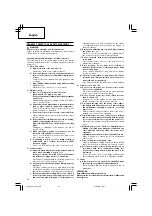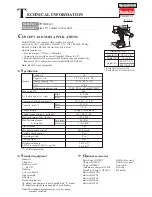
26
English
TABLE 1
Shift lever indication
1
2
[Low speed gear]
[High speed gear]
Dial
Materials to be drilled
Types of drills
Drill
A
B
C
D
E
A
B
C
D
E
diameters
Brick, Block
Diamond
φ
27
core bit
φ
65
φ
152
ALC t3.0
Hole saw
φ
27
φ
65
φ
120
Steel
Hole saw
φ
15
SPCC t3.0
φ
55
Stainless steel
Hole saw
φ
15
t1.6
φ
55
Wood
Hole saw
φ
27
t50
φ
65
φ
120
Steel SPCC t3.0
Drill
φ
13
Wood t50
Drill
φ
30
3. When drilling completely through the material:
When the drill bit bores completely through the
material, careless handling often results in broken
drill bit or damage to the drill body itself due to the
sudden movement of the drill.
Always be alert and ready to release pushing force
when drilling through the material.
4. Diamond Core drilling
(1) Place the diamond core bit in the drilling location.
(2) When drilling, always hold the tool squarely against
the material.
(3) Do not force the core bit, but allow the core bit to do
the work. This will prolong the life of the core bit and
reduce breakage.
(4) Ensure that masonry dust/swarf produced during
drilling is regularly removed. Allowing dust/swarf to
accumulate will result in overheating and excessive
clutch/torque limiter wear and loss of segments from
the core bit.
(5) When entering or leaving a hole, ensure that the core
bit is rotating.
(6) If the core bit starts to vibrate and when the core bit
begins to break through the material, reduce pressure
immediately.
(7) After use, store the core bit carefully in its box and
remember that it is a diamond core bit.
c
Drilling method by using Pilot Spigot
v
For easy positioning, carry out the following steps
when using a diamond core bit.
(1) Make a pilot hole at the center position of the material
to be drilled with a 13 mm stone drill bit.
(2) Attach a pilot spigot to a diamond core bit.
(3) Align the pilot spigot to the pilot hole and begin the
drilling operation to make a guide groove.
(4) When making the guide groove, temporarily stop the
drilling operation and remove the pilot spigot.
(5) Align the diamond core bit with the guide groove and
start the drilling operation again.
CAUTION
䡬
When drilling with a diamond core bit, there will be a
high force of reaction load to your hands. Make sure
to hold the handle of the main body and the side
handle.
Safety-Release Clutch
This tool is equipped with a positive type Safety-
Release Clutch. The clutch will slip when a certain
torque level is required, causing the motor to
disengage from the output shaft. When this happens,
the chuck will stop turning.
CAUTION
䡬
Immediately pull away the main body when the
Safety-Release Clutch starts its operation.
䡬
Do not continue to operate the tool for more than two
seconds while the clutch is slipping.
䡬
Do not let the Safety-Release Clutch activate too
frequently.
5. Drilling with a conventional drill bit
(1) Drilling in wood
Use a woodworking drill bit. However, use an
metalworking drill bit when drilling a hole which is
less than 6.5 mm in diameter. The usable drill bit
diameter is maximum 30 mm.
(2) Drilling in mild steel or plastics
Use a conventional metalworking drill bit. The usable
drill bit diameter is minimum 1.2 mm and maximum
13 mm.
05Eng_DC120VA_NE
12/25/08, 18:01
26






































